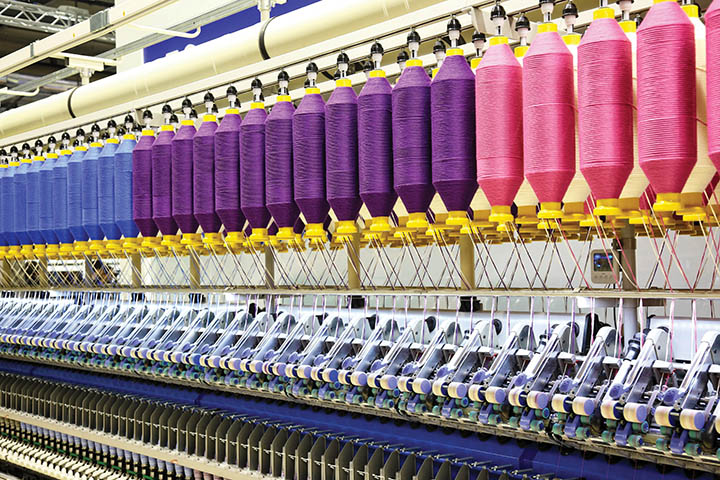In a world where 96% of products – including textiles – rely on chemical intermediates for their manufacture, the chemical industry urgently needs to find alternatives to fossil-based feedstocks to help tackle the climate crisis. In contrast to oil or natural gas, the use of renewable carbon from wood to produce bio-based products will have a crucial role – alongside carbon from direct CO2 utilization and carbon from recycling of existing materials – in delivering a net zero future, argues Martin Ledwon, Vice President Sustainability, UPM Biorefining.
The risks of climate change now need little introduction. We are already starting to live with the impacts of a changing climate on the environment, communities, businesses and supply chains. The ambition to limit global warming to 1.5°C is now hanging by a thread, with voices challenging whether keeping within the 1.5°C trajectory is even still feasible – now making each 0.1°C rise above 1.5°C hugely significant.
With an increasingly narrow window to stabilize climate, it is now incumbent upon major primary industries to take a broader approach to sustainability than solely through decarbonizing of energy sources. In addition to championing a truly circular economy, due to its immense responsibility to supply intermediate products to downstream manufacturers, the chemicals industry needs to curb its high dependency on fossil fuel completely. Specifically, this means finding alternative, renewable feedstocks to replace current petroleum-based ones in the production of chemical intermediates.
Often referred to as “renewable carbon,” the alternative feedstock sources available today are from biomass (typically wood, crops, manure, algae, etc.), from carbon capture or from the recycling of materials already used. For the purposes of this discussion, we are focusing on wood. Not only is it one of the most widely available feedstock sources – and, operationally speaking, one of the easiest to directly replace fossil-based sources – its chemical make-up allows for similar or even enhanced performance characteristics to their fossil-based counterparts.
At the Root of the Problem
Only two years ago, textile consumption in Europe ranked fourth with regard to the highest impact on the environment and climate change globally. It also had the third highest impact on water and land use – and the fifth highest in terms of raw material use and greenhouse gas emissions.1 And if that wasn’t damning enough, approximately 60% of all materials used by the fashion industry2 and 70% used in homeware textiles,3 are made from fossil-based polymers.
It is evident that industries relying on textiles – from fashion to homewares – are facing a major challenge to align themselves with sustainability strategies of other industries. But we need to look back through the textile production value chain to find the real root of the problem. The chemicals industry – which is largely responsible for the vast number of fossil-based materials – has been slow in its ambition to develop innovative, less CO2-intensive feedstocks for textile materials.

The Chemicals System: Beginning of the Story
The global chemical industry is responsible for a vast number of man-made textiles which form a significant part of our modern consumer world – everything from clothing, footwear and bedding to furnishings, carpeting, car interiors and much more.
Producing synthetic fibers or a mix of natural and synthetic materials, the industry generates over $3.5 trillion in revenues annually, representing around 4% of global GDP – roughly equal to the output of Russia, the world’s fourth largest emitting country – and directly employing over 11 million people.4 But it also accounts for 4% of global greenhouse gas emissions,5 of which the International Energy Agency (IEA) estimates 75% is from the production of large-volume chemical intermediates (e.g., ethylene, propylene, benzene, toluene, ammonia, and methanol).6 And this does not include the emissions from the vast array of allied industries which rely on chemical intermediates essential to almost all sectors of the economy. These chemicals are present in the healthcare, personal hygiene, packaging, agriculture, textiles, automotive, construction and many other systems, with 96% of manufactured goods depending on their use.7
Replacing fossil-based feedstocks – such as oil and natural gas – with renewable sources will lead to significant reductions in greenhouse gas (GHG) emissions. According to the American Chemical Society (ACS), even under the most conservative assumptions (i.e., 25% conversion and high separation energy), biochemicals can reduce GHG emissions by up to 88% – and up to 94% under the most optimistic conditions (i.e., 75% conversion and easy separation).8
However, the chemical industry has so far lagged behind other sectors in transitioning their operations to sustainable models of operation – and until it does, it is impossible for other sectors reliant on chemical products to be truly sustainable.
Today, the global chemical value chain is predominantly linear, with low reuse and recycling rates and significant waste generation. For a transition to a more environmentally-friendly mode of operating to become a reality, the chemical industry needs to take a broader approach to sustainability than solely abating climate impacts through decarbonizing of energy sources. It needs to curb its high dependency on fossil fuel completely. Specifically, this means finding alternative carbon sources to petroleum-based feedstocks for its chemical intermediates. In order for the industry to seriously play its part in becoming more sustainable, it is estimated that at least 59% of its feedstock (and up to 93%) should come from sustainable sources by 2050 – up from less than 5% in 2020.9

While most countries now have an unambiguous strategy towards transitioning to 100% renewable energy systems by 2050 or 2060 based on solar, wind, hydrogen and other renewable energies, there are few corresponding policies or strategies which demand the same of material feedstocks. This means we are largely reliant on the demands by downstream industries – and their consumers – for more sustainable products. Plus, the foresight and sustainability ambitions of innovative chemical producers.
But with almost the entire carbon feedstock used in the chemical system currently from virgin fossil sources, the transition to alternative feedstocks represents an enormous challenge. However, one bio-chemical innovator that has risen to the challenge – Finnish company, UPM Biochemicals – will be the first to produce wood-based biochemicals on a large scale, with its €750 million biorefinery at Leuna in the German federal state of Saxony-Anhalt. Renewable wood-based biochemicals are one of the most innovative, yet practical solutions to the fossil-based feedstock transition, offering brand owners and material producers exciting new opportunities for improving their environmental performance.
And UPM has ensured its wood-based feedstocks have sustainability built into each and every part of its value chain. All the wood used is fully traceable and supported by a verified third-party chain of custody, either FSC®- or PEFC-certified, and sourced from regional forests. Up to 60%, by far largest part of the wood harvested in Germany, is currently used for energy generation. It is burned. However, its use in long-life and recyclable products would make the best of the renewable carbon provided by wood and have a bigger impact in mitigating climate change. Valuing wood, using it wisely in the post-fossil world means we need to reduce the amount of wood used for fuel and energetic use and increase its material use to foster a circular economy and work towards zero virgin fossil feedstock.
Look to the Forest
Trees are composed of 20-30% of lignin, a complex polymer found in the wood cell walls and giving wood its stiffness and resistance to degradation. This valuable compound can serve as raw materials in the production of bio-based chemicals which can be used in the manufacture of man-made fibers, among many other products. Lignin also offers UV and temperature stability, and even enhances moisture resistance, so helping to prevent bacterial and fungal attack. It is these properties that make lignin an ideal bio-based substitute for various petroleum-based products used today. Lignin has already found its way into a rapidly growing number of industrial applications such as resins, adhesives, bio-plastics, and polyurethanes. And not only do trees provide an environmentally friendly alternative to fossil-based feedstocks, they also absorb large amounts of CO2 during their growing phase and currently represent the only scalable “negative emissions” strategy. And trees of all varieties contribute significantly to improving biodiversity and wildlife habitats.
Not only is lignin bio-based, but the chemical intermediates that can be produced from it have the same chemical properties and performance as fossil-based chemicals and require no operational changes or retrofitting of existing manufacturing facilities. And its direct substitution for fossil-based feedstocks has a vast array of applications – particularly for the textile industry.
And the benefit of wood-based feedstock reaches far beyond just reducing emissions from the chemical production process. In addition to reducing the carbon footprint of an end product during the manufacturing phase, the carbon sequestered from the atmosphere by the trees is retained throughout the whole manufacturing process – so within the wood feedstock, the subsequent biochemical intermediate and even into the end product where it remains locked-in for life.

For our new state-of-the-art biorefinery, which is due to become operational in 2024, UPM will primarily use beechwood feedstock, from which it will produce 220,000 tonnes of biochemical intermediates annually. Beech trees are native to Germany and, as a species considered central to the country’s long-term strategy to become more resilient to climate change. Forests in Central Europe are being rebuilt to become more diverse and climate resilient and a mix of species, nature protection and biodiversity standards are central to these regeneration efforts. This also means that new economical end uses must emerge which we provide as part of a push towards de-fossilizing chemical and material value streams.
Beech has long been in demand in the furniture sector, but because manufacturers only want the trunks, the branches and forest management by-products have typically been incinerated, resulting in both a waste of high-quality, usable raw material and contributing further to CO2 emissions.
UPM’s beechwood, including branches and off-cuts, are sourced from certified (FSC/PEFC), locally managed local forests, so neither competes for land for food production, nor requires fertilizers – two of the biggest criticisms of some other bio-feedstocks such as sugarcane. UPM also oversees the responsible planting, growing, harvesting and collection of beech trees, plus the residues and so-called thinnings from sawmill operations – of which around 70% normally ends up being incinerated.
It’s from this fully sustainable source that UPM Biochemicals has developed a new generation of renewable bio-based “drop-in” glycols. Mono-ethylene glycols (MEG), polyurethanes (PU) and polyethylene terephthalate (better known as PET or polyester) are vital ingredients in the production of man-made fibers and materials used in the manufacture of countless types of textiles.
Integration into existing manufacture can be easily implemented because UPM’s bio-glycol, BioPura™ is a molecular like-for-like substitute, enabling a much more sustainably sourced, virgin bio-polyester to be manufactured. Ideally, this bio-polyester will be mechanically recycled at the end of life, just as fossil-based polyester should be. If the polyester can’t be mechanically recycled anymore, it can be chemically recycled using ‘glycolysis’. This process requires additional MEG to create new recycled polyester and using BioPura™ here will create a holistic circular economy in the polyester value chain.
A Case in Point
UPM Biochemicals and Dongsung Chemical, headquartered in South Korea, recently announced a partnership to accelerate the introduction of renewable, sustainable forest-sourced materials into the Asian market in order to reduce fossil resource consumption. With manufacturing of textiles heavily concentrated in countries across Asia – including 88% of all footwear – the collaboration represents a milestone in the development a renewable polyurethane product based on UPM Biochemicals’ biobased mono-ethylene glycols (MEG), UPM BioPura.™ Initially Dongsung will use the new bio-based MEG to develop renewable polyurethane (PU) – for which glycol is a primary constituent – for the footwear market. Mid soles – particularly for athletic footwear – are usually manufactured from fossil-based PU, and while some fossil materials will still be present, the addition of the bio-based PU will be a major advancement in Dongsung’s ambitions to develop more eco-friendly materials. Indeed, there are
already plans to expand the field of application to automotive interior materials and adhesives.
Sustainable Choices
Wood is one of humanity’s most ancient raw materials but it can also take us into the future.
UPM Biochemicals is at the vanguard of the transition to a circular bioeconomy – where sustainable, renewable production and consumption is the new normal. It is pioneering sustainable chemistry – innovating in chemical processes, scaling biorefining and unlocking the potential of biomass to transform industries.
Replacing fossil and mineral-based materials with wood-based biochemical ingredients will also lock-in carbon sequestered from the atmosphere for the life of the product. This enables us to radically reduce the carbon footprint of materials and provide better, more sustainable choices to consumers.
References:
- European Environment Agency; Textiles and the environment: the role of design in Europe’s circular economy; February 10, 2022
- UN Environment Program; Fashion’s Tiny Hidden Secret; March 13, 2019
- As per reference 1 above
- Systemiq; Planet Positive Chemicals: A Pathway for the Chemical Industry to Enable a Sustainable Global Economy; September 2022; page 9
- As above
- Greenhouse Gas Emission Mitigation Potential of Chemicals Produced from Biomass; October 20, 2021; American Chemical Society; Kefeng Huang et al
- American Chemistry Council; The Business of Chemistry by the Numbers
- As per reference 5 above
- As per 3 above; page 40


